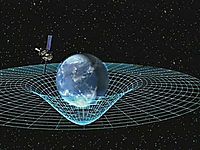
Photo from wikipedia
The variations of short-range correlations (SRC) across nuclei can be quantified in an approximately model-independent fashion in terms of the so-called SRC scaling factors. We provide predictions for the SRC… Click to show full abstract
The variations of short-range correlations (SRC) across nuclei can be quantified in an approximately model-independent fashion in terms of the so-called SRC scaling factors. We provide predictions for the SRC scaling factors for both bound protons and bound neutrons across the nuclear periodic table and determine the contribution of the different nucleon pair combinations to this quantity. Thereby we employ the low-order correlation operator approximation (LCA) to compute the SRC contribution to the single-nucleon momentum distribution. We do this for a sample of fifteen nuclei from He to Pb thereby gaining access to the evolution of the SRC scaling factor with the nuclear mass and the neutron-to-proton ratio. For the studied sample of fifteen nuclei, the total SRC scaling factor is in the range 4.05-5.14. The computed SRC scaling factors in the LCA are in line with those of ab-initio calculations and with measured quantities from SRC-sensitive inclusive electron-scattering data. In asymmetric nuclei there are sizeable differences between the SRC scaling factors for protons and neutrons. It is suggested that this phenomenon may impact the variations of the magnitude of the European muon collaboration (EMC) effect across nuclei. Our results corroborate the finding that SRC physics can be qualitatively understood by universal principles that build on local modifications of mean-field wave functions of nucleon pairs.
Journal Title: Physical Review C
Year Published: 2019
Link to full text (if available)
Share on Social Media: Sign Up to like & get
recommendations!